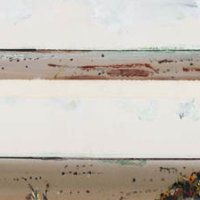35. FRED WILLIAMS

Fred Williams observed and conceptualised views of the Australian bush are recognised as embodying the essence of the landscape in a way not previously seen in Australian art. In the early 1960s, the artist began taking daytrips to areas around Melbourne where he would paint en plein air with gouche to quickly capture the light and conditions of the landscape around him. By working on the spot, Williams was able to record the eternal bush with immediacy and clarity. These gouaches and drawings produced while standing in front of his subjects would then become the basis of the larger oil paintings produced in the studio.
Following the thorough exploration of the Sherbrooke and Echuca subjects through his paintings and prints, Fred Williams was ready for a new subject to paint - he found this new subject at the You Yangs. He had discovered these curious granite hills as he sailed up Port Phillip Bay into Melbourne on his return from London in January 1957. The You Yangs are a range of rocky hills that rise out of the volcanic plain to the west of Melbourne. From his first visit he liked the scale of the landscape. From Big Rockthere was a birds-eye view of miles of plain stretching towards the bay. He preferred to paint from near the top of the hills, finding his subject in the middle distance, just as he knew Corot had done.1
The present work, You Yangs Outlook (1970), most likely painted from Big Rock, presents the view looking out towards the plains. Here, Williams painted the vista using the innovative strip technique, a method the artist began utilising with his gouaches in the early 1970s. The idea first came to him in 1969 when painting on the Howqua River near Mansfield in north-eastern Victoria, and further developed in the 1970 gouaches painted from the AMP tower in Bourke Street, Melbourne and in the striking The Mouth of the Yarra River in the collection of the National Gallery of Australia, Canberra. By placing strips across the paper, Williams could concentrate on the subject that interested him; there was no room for the foreground to make its way into the composition and distract from what it was he was trying to paint. The double strips of these gouaches developed into three, then four, as seen in the beachscapes of Sorrento, Walkerville, and Queenscliff, which he painted in the summer of 1970-71. The same subject might be painted at different times of day, with changing light and atmospheric conditions. In the present work, You Yangs Outlook, Williams painted the same vista twice, capturing the impact that light and shadow had in changing the atmosphere of the landscape. When presented one above the other, as they are here, the viewer can appreciate what it was Williams was trying to achieve with his use of the strip technique.
The You Yangs were a rich source of inspiration for Williams and following the outward-looking views, the artist began moving even further into the landscape to paint just the hill itself, doing away with the horizon to create the characteristically ambiguous Williams landscape.2 The You Yangs paintings were breakthrough works in regards to his treatment of the landscape in general and his oeuvre. From the first series of oil paintings, You Yangs Landscape II and Knoll in the You Yangs II were purchased by the National Gallery of Australia. The You Yangs series continues to be amongst Williams best and most sought after paintings from his entire body of work. You Yangs Landscape I (1963) achieved the highest secondary market price for a work by the artist when it sold in 2013 for $2,287,500 (including buyers premium).3
Footnotes
1. Mollison, J., A Singular Vision: the Art of Fred Williams, Oxford University Press, 1989, p.77
2. ibid
3. You Yangs Landscape I 1963, oil on masonite, 137.0 x 180.5 cm, Bonhams, The Grundy Collection, Sydney, 26 June 2013, lot 49
Caroline Jones BA MArtAdmin